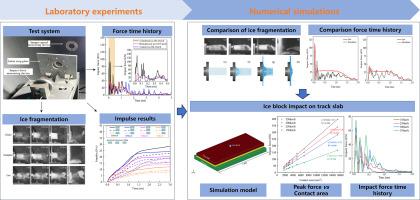Experimental and numerical investigation of impact force characteristics on track slabs subjected to high-speed ice impacts
IF 3.8
2区 工程技术
Q1 ENGINEERING, CIVIL
引用次数: 0
Abstract
The impact effect caused by ice blocks detaching from high-speed trains will impair track performance. As the accurate impact force is not only a critical evaluation indicator for the impact damage on track slabs, but also a key input parameter to investigate the damage evolution mechanisms, the impact force characteristics is a primary issue to be addressed. Herein, the ice impact behavior and the influence of ice size, head shape, and impact velocity on force characteristics were investigated through a combination of laboratory experiments and numerical simulations. The impact force was directly measured by the force transducer during impact event, and the impacting fragmentation process of ice block was recorded by the high-speed camera. The numerical models developed by Ls-Dyna were validated through correlation with experimental data, and the relationship between experimental data and calculated results was analyzed. The findings reveal that peak impact forces across all test conditions exhibit an approximately linear growth trend with increasing impact velocity. Larger initial contact areas result in higher peak forces, shorter rise time, and greater impulse magnitudes compared to smaller ones, while the mass of the ice blocks has minimal impact on peak force and rise time. In addition, it is observed that the total impulse of ice blocks, regardless of their head shape or mass, exhibits a linear increase with rising kinetic energy. Additionally, initial fragmentation characteristics were highly dependent on the ice block shape: cylindrical blocks exhibited global fragmentation, while conical blocks demonstrated localized fragmentation. These insights, derived from the numerical and experimental analyses, were used to predict ice impact damage to the track slab, thereby laying the foundation for further research on the characterization and classification of impact damage.

高速冰冲击下轨道板冲击力特性的实验与数值研究
高速列车上冰块脱落所产生的冲击效应会影响轨道的性能。准确的冲击力既是轨道板冲击损伤的重要评价指标,也是研究轨道板冲击损伤演化机制的关键输入参数,因此冲击力特性是轨道板冲击损伤研究的首要问题。通过室内实验和数值模拟相结合的方法,研究了冰的冲击行为,以及冰的尺寸、头部形状和冲击速度对力特性的影响。通过力传感器直接测量冲击过程中的冲击力,并通过高速摄像机记录冰块的冲击破碎过程。通过与实验数据的关联验证了Ls-Dyna建立的数值模型,并分析了实验数据与计算结果之间的关系。结果表明,随着冲击速度的增加,所有试验条件下的峰值冲击力均呈近似线性增长趋势。与较小的初始接触面积相比,较大的初始接触面积导致更高的峰值力、更短的上升时间和更大的冲量,而冰块的质量对峰值力和上升时间的影响最小。此外,还观察到冰块的总冲量随动能的增加呈线性增加,无论其头部形状或质量如何。此外,初始破碎特征高度依赖于冰块形状:圆柱形块表现为全局破碎,而锥形块表现为局部破碎。通过数值分析和实验分析得出的结论可用于轨道板冰冲击损伤的预测,为进一步研究冲击损伤的表征和分类奠定基础。
本文章由计算机程序翻译,如有差异,请以英文原文为准。
求助全文
约1分钟内获得全文
求助全文
来源期刊

Cold Regions Science and Technology
工程技术-地球科学综合
CiteScore
7.40
自引率
12.20%
发文量
209
审稿时长
4.9 months
期刊介绍:
Cold Regions Science and Technology is an international journal dealing with the science and technical problems of cold environments in both the polar regions and more temperate locations. It includes fundamental aspects of cryospheric sciences which have applications for cold regions problems as well as engineering topics which relate to the cryosphere.
Emphasis is given to applied science with broad coverage of the physical and mechanical aspects of ice (including glaciers and sea ice), snow and snow avalanches, ice-water systems, ice-bonded soils and permafrost.
Relevant aspects of Earth science, materials science, offshore and river ice engineering are also of primary interest. These include icing of ships and structures as well as trafficability in cold environments. Technological advances for cold regions in research, development, and engineering practice are relevant to the journal. Theoretical papers must include a detailed discussion of the potential application of the theory to address cold regions problems. The journal serves a wide range of specialists, providing a medium for interdisciplinary communication and a convenient source of reference.
 求助内容:
求助内容: 应助结果提醒方式:
应助结果提醒方式:


